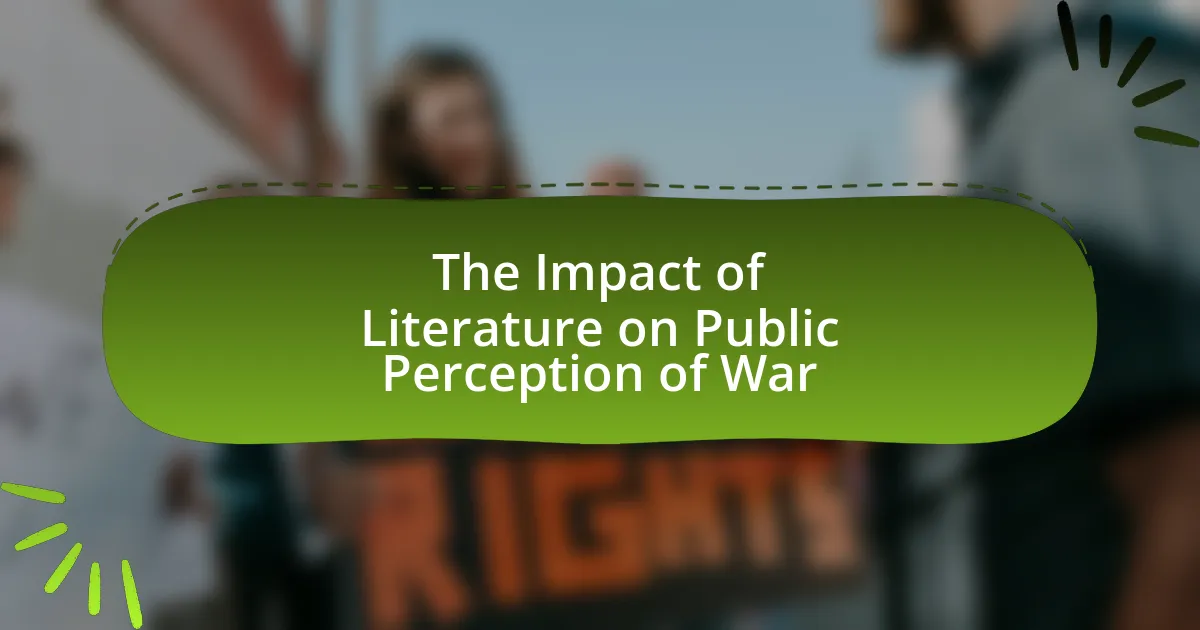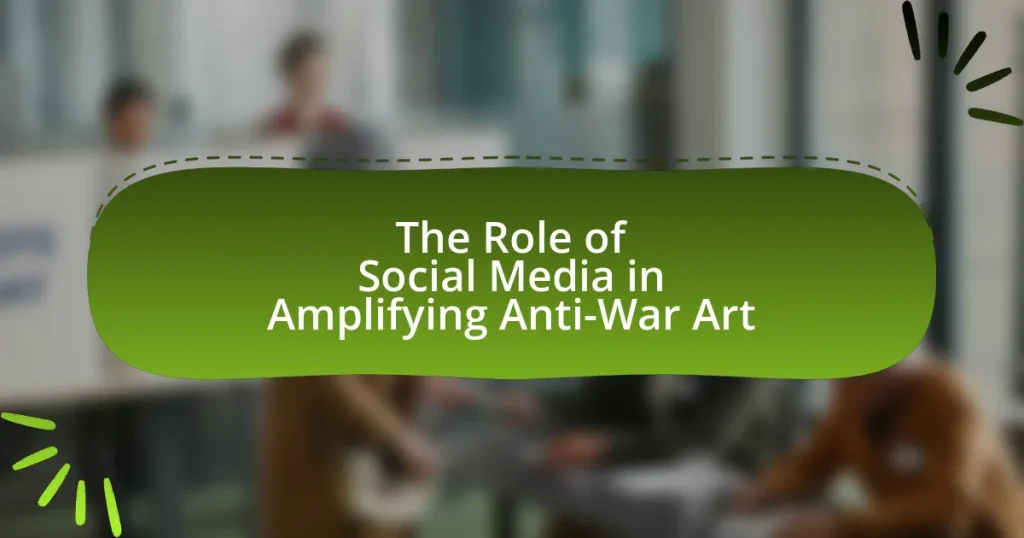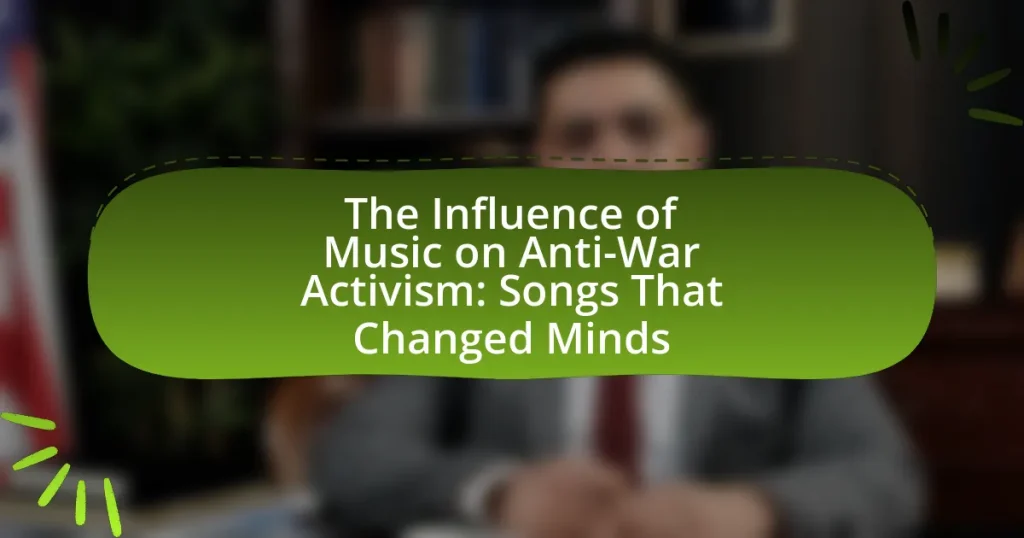The article examines the impact of literature on public perception of war, highlighting how narratives, poetry, and essays shape emotions, beliefs, and attitudes toward conflict. It discusses the role of various literary genres, such as historical fiction, poetry, and memoirs, in humanizing the experiences of soldiers and civilians, thereby fostering empathy and understanding. Key examples include Erich Maria Remarque’s “All Quiet on the Western Front” and Tim O’Brien’s “The Things They Carried,” which challenge glorified notions of warfare and contribute to anti-war sentiments. The article also explores the psychological mechanisms at play when readers engage with war literature and the effectiveness of literary works in fostering dialogue about war and peace.
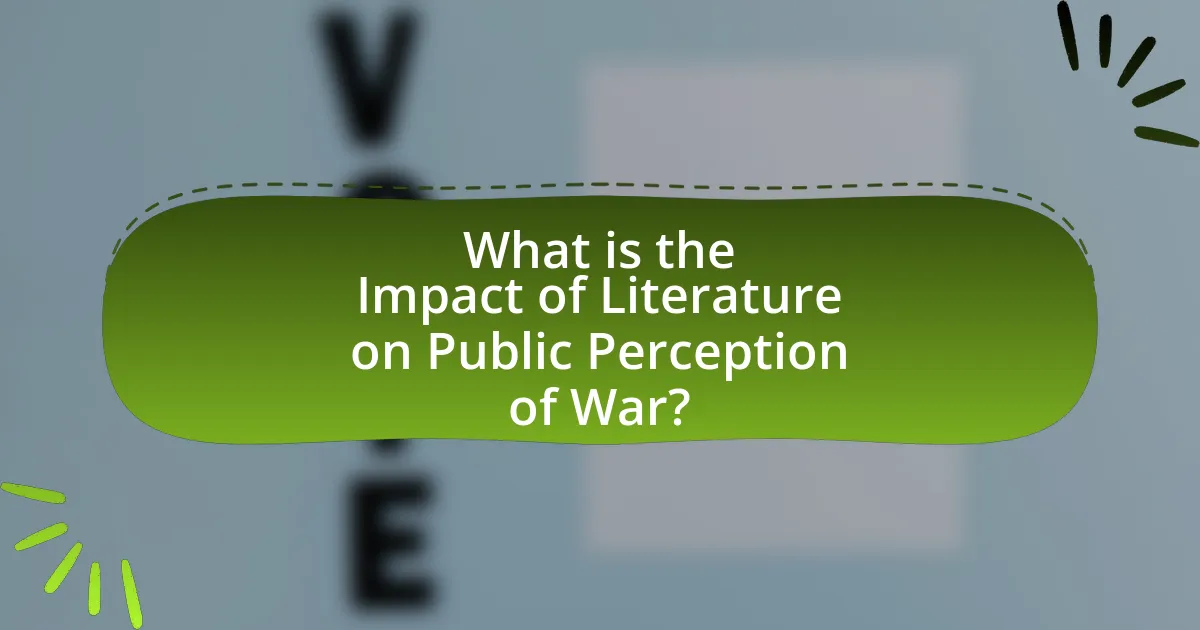
What is the Impact of Literature on Public Perception of War?
Literature significantly shapes public perception of war by influencing emotions, beliefs, and attitudes toward conflict. Through narratives, poetry, and essays, literature provides personal and humanized accounts of war, which can evoke empathy and understanding among readers. For instance, works like Erich Maria Remarque’s “All Quiet on the Western Front” and Tim O’Brien’s “The Things They Carried” illustrate the psychological and emotional toll of war, challenging glorified notions of heroism and valor. These literary depictions can alter public sentiment, often leading to increased anti-war sentiments or calls for peace, as evidenced by the impact of literature during the Vietnam War era, where novels and poetry played a crucial role in shaping public opinion against the conflict.
How does literature shape societal views on war?
Literature shapes societal views on war by providing narratives that influence public perception and understanding of conflict. Through novels, poetry, and essays, authors depict the realities of war, often highlighting its brutality, moral complexities, and human cost. For instance, Erich Maria Remarque’s “All Quiet on the Western Front” presents a harrowing portrayal of World War I, challenging romanticized notions of warfare and fostering anti-war sentiments among readers. Additionally, literature serves as a historical record, offering insights into the experiences of soldiers and civilians, which can alter societal attitudes towards military engagement. Studies have shown that literary works can evoke empathy and provoke critical discussions about the ethics of war, thereby shaping collective consciousness and policy debates.
What literary genres are most influential in shaping perceptions of war?
The literary genres most influential in shaping perceptions of war are historical fiction, poetry, and memoirs. Historical fiction often dramatizes real events, allowing readers to engage emotionally with the complexities of war, as seen in works like “All Quiet on the Western Front” by Erich Maria Remarque, which highlights the brutal realities faced by soldiers. Poetry, such as Wilfred Owen’s “Dulce et Decorum Est,” captures the visceral experience of combat and critiques romanticized notions of war. Memoirs, like “The Things They Carried” by Tim O’Brien, provide personal narratives that humanize the experiences of soldiers, fostering empathy and understanding. These genres collectively influence public perception by blending factual elements with emotional storytelling, thereby shaping societal attitudes toward war.
How do narratives in literature reflect or distort the realities of war?
Narratives in literature reflect and distort the realities of war by shaping public perception through emotional engagement and selective storytelling. For instance, novels like “All Quiet on the Western Front” by Erich Maria Remarque provide a visceral depiction of the horrors of World War I, emphasizing the psychological trauma experienced by soldiers, which aligns closely with historical accounts of trench warfare. Conversely, works such as “The Red Badge of Courage” by Stephen Crane can romanticize the experience of battle, focusing on individual heroism and glory, which may lead to a distorted understanding of the brutal realities faced by soldiers. This duality illustrates how literature can both illuminate and obscure the complexities of war, influencing societal attitudes and beliefs about conflict.
Why is literature a powerful tool in influencing public opinion about war?
Literature is a powerful tool in influencing public opinion about war because it shapes narratives and evokes emotional responses that can alter perceptions. Through storytelling, literature provides personal perspectives on the experiences of war, making abstract concepts tangible and relatable. For instance, works like Erich Maria Remarque’s “All Quiet on the Western Front” vividly depict the horrors of World War I, leading to widespread anti-war sentiments. Additionally, literature can challenge prevailing ideologies and highlight the moral complexities of conflict, as seen in novels like “Slaughterhouse-Five” by Kurt Vonnegut, which critiques the glorification of war. These narratives resonate with readers, fostering empathy and understanding, ultimately swaying public opinion against war.
What psychological mechanisms are at play when readers engage with war literature?
Readers engage with war literature through psychological mechanisms such as empathy, identification, and moral reflection. Empathy allows readers to connect emotionally with characters and their experiences, fostering a deeper understanding of the human cost of war. Identification occurs when readers see aspects of themselves in the characters, which can lead to a personal investment in the narrative and its outcomes. Moral reflection prompts readers to contemplate ethical dilemmas presented in the literature, challenging their beliefs and values regarding conflict and violence. These mechanisms are supported by studies indicating that literature can enhance empathy and moral reasoning, such as the research by Mar et al. (2006) published in “Psychological Science,” which found that reading fiction improves emotional intelligence and understanding of others’ perspectives.
How does the emotional resonance of literature affect public perception of war?
The emotional resonance of literature significantly shapes public perception of war by humanizing the experiences of soldiers and civilians, fostering empathy and understanding. For instance, novels like “All Quiet on the Western Front” by Erich Maria Remarque illustrate the brutal realities of combat, which can alter readers’ views on the glorification of war. Research indicates that literature can evoke strong emotional responses, leading to increased awareness and critical reflection on the consequences of conflict. This emotional engagement often results in a more nuanced public discourse surrounding war, as seen in the impact of works like “The Things They Carried” by Tim O’Brien, which highlights the psychological burdens of soldiers, thereby influencing societal attitudes towards veterans and military actions.
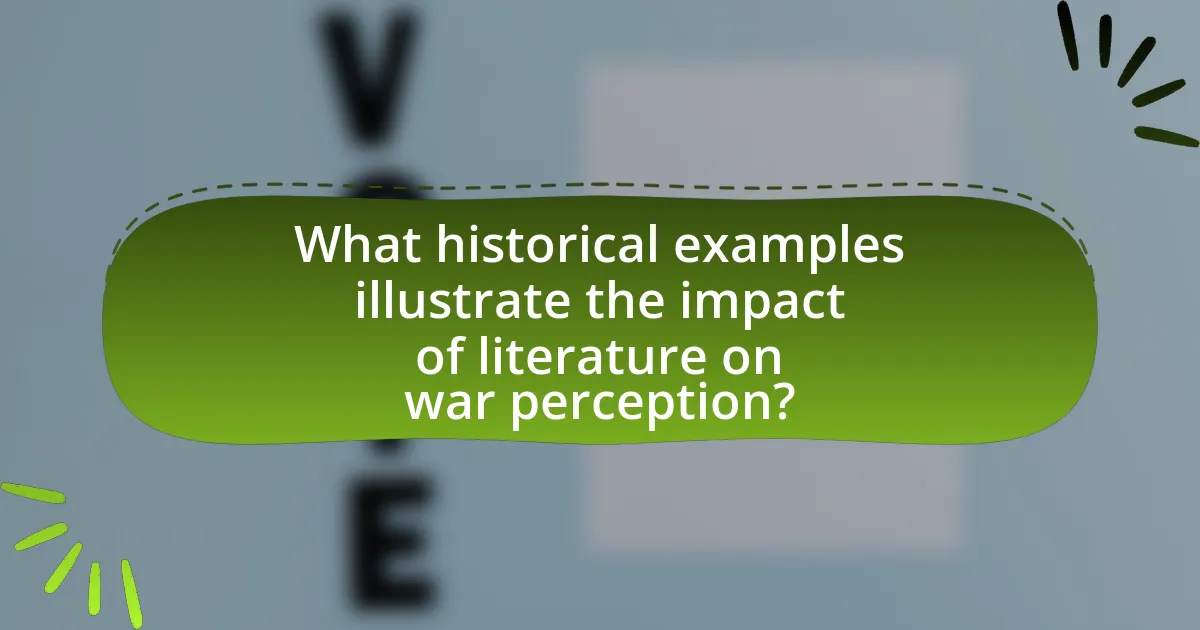
What historical examples illustrate the impact of literature on war perception?
Literature has significantly influenced public perception of war, with notable examples including Erich Maria Remarque’s “All Quiet on the Western Front,” which depicted the grim realities of World War I, challenging romanticized notions of warfare. This novel, published in 1929, resonated with readers and contributed to anti-war sentiments by illustrating the psychological trauma faced by soldiers. Another example is John Steinbeck’s “The Grapes of Wrath,” which, while primarily about the Great Depression, also addressed the socio-political climate leading to World War II, shaping perceptions of the conflict’s underlying causes. Additionally, the poetry of Wilfred Owen, particularly “Dulce et Decorum Est,” vividly portrayed the horrors of trench warfare, influencing public understanding of the brutalities of combat. These literary works collectively altered societal views on war, fostering critical discourse and empathy towards those affected by conflict.
How did World War I literature influence public sentiment during and after the war?
World War I literature significantly influenced public sentiment during and after the war by shaping perceptions of the conflict and its consequences. Works such as Erich Maria Remarque’s “All Quiet on the Western Front” and Wilfred Owen’s poetry depicted the brutal realities of trench warfare, challenging the glorified narratives of heroism and patriotism. These literary pieces resonated with readers, fostering a sense of disillusionment and empathy towards soldiers’ experiences. The widespread publication of these works contributed to a growing anti-war sentiment, as they highlighted the psychological and physical toll of the war, ultimately influencing public discourse and policy regarding future conflicts.
What specific works became emblematic of the anti-war sentiment?
Specific works that became emblematic of the anti-war sentiment include “Slaughterhouse-Five” by Kurt Vonnegut, “All Quiet on the Western Front” by Erich Maria Remarque, and “The Things They Carried” by Tim O’Brien. “Slaughterhouse-Five,” published in 1969, critiques the absurdity of war through the lens of a soldier’s experiences in World War II, particularly the bombing of Dresden. “All Quiet on the Western Front,” released in 1929, provides a harrowing account of World War I from the perspective of German soldiers, highlighting the brutal realities of combat. “The Things They Carried,” published in 1990, explores the emotional burdens of soldiers during the Vietnam War, emphasizing the psychological impact of warfare. These works collectively reflect the disillusionment and moral questioning surrounding war, resonating deeply with public sentiment against military conflict.
How did these works change the narrative surrounding soldiers and civilians?
These works changed the narrative surrounding soldiers and civilians by humanizing both groups and highlighting their shared experiences during wartime. Literature such as “All Quiet on the Western Front” by Erich Maria Remarque and “The Things They Carried” by Tim O’Brien depicted the psychological and emotional toll of war, illustrating that soldiers are not just combatants but individuals grappling with trauma, while civilians are often portrayed as victims of conflict. This shift in narrative fostered empathy and understanding among the public, challenging the glorification of war and emphasizing the complexities of human relationships in times of conflict. For instance, Remarque’s portrayal of soldiers’ disillusionment contrasted sharply with traditional heroic narratives, prompting readers to reconsider the impact of war on both soldiers and civilians.
What role did literature play in shaping perceptions during the Vietnam War?
Literature played a crucial role in shaping perceptions during the Vietnam War by providing narratives that influenced public opinion and understanding of the conflict. Works such as “The Things They Carried” by Tim O’Brien and “Dispatches” by Michael Herr presented personal experiences and emotional truths that contrasted with official government narratives, highlighting the war’s brutality and moral complexities. These literary accounts contributed to a growing anti-war sentiment by humanizing soldiers and illustrating the psychological toll of combat, thereby fostering empathy among readers. The impact of literature during this period is evidenced by its ability to spark discussions and debates, ultimately shaping societal views on the war and its implications.
Which authors and works were pivotal in altering public views on the Vietnam War?
Authors and works pivotal in altering public views on the Vietnam War include Tim O’Brien’s “The Things They Carried,” which humanizes the experiences of soldiers and highlights the emotional burdens of war. Additionally, Michael Herr’s “Dispatches” provides a visceral account of the war’s brutality, influencing perceptions through its raw depiction of combat. Joan Didion’s “The White Album” also critiques American culture and politics during the Vietnam era, shaping public discourse. These works collectively contributed to a shift in understanding the complexities and consequences of the Vietnam War, as evidenced by their lasting impact on literature and public sentiment.
How did literature contribute to the anti-war movement during this period?
Literature significantly contributed to the anti-war movement by shaping public perception and fostering critical discourse about the consequences of war. Works such as “All Quiet on the Western Front” by Erich Maria Remarque and “Slaughterhouse-Five” by Kurt Vonnegut vividly depicted the horrors of combat and the psychological toll on soldiers, which resonated with readers and sparked widespread anti-war sentiment. These narratives provided personal and emotional insights into the realities of war, countering glorified portrayals and encouraging a more skeptical view of military conflict. The impact of these literary works was evident in the growing protests and activism during the Vietnam War era, where literature became a tool for mobilization and awareness, influencing public opinion and policy.
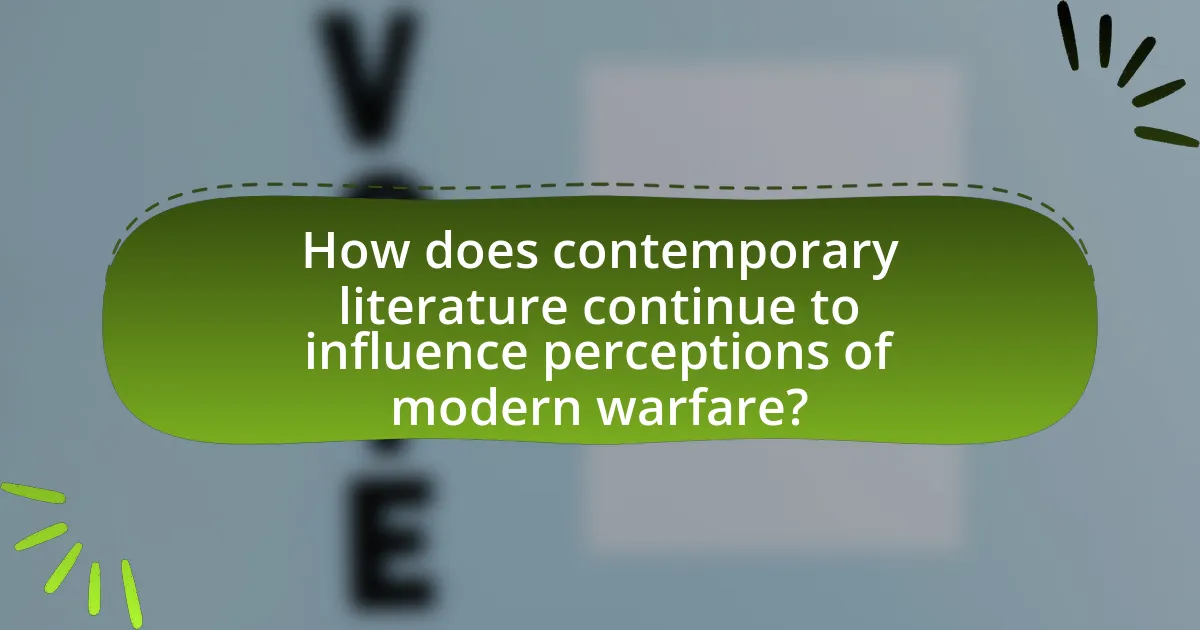
How does contemporary literature continue to influence perceptions of modern warfare?
Contemporary literature significantly influences perceptions of modern warfare by providing nuanced narratives that challenge traditional views of conflict. Through diverse storytelling, authors like Kevin Powers in “The Yellow Birds” and Phil Klay in “Redeployment” depict the psychological and moral complexities faced by soldiers, thereby humanizing their experiences. These narratives often highlight the disconnect between the glorified image of war and its harsh realities, fostering critical discussions among readers. Research indicates that literature can shape public opinion by evoking empathy and understanding, as seen in studies that link literary engagement with increased awareness of the consequences of war. Thus, contemporary literature serves as a powerful medium for reshaping societal perceptions of modern warfare.
What themes are prevalent in modern literature about war?
Prevalent themes in modern literature about war include the futility of conflict, the psychological impact on soldiers, and the moral ambiguity of warfare. These themes reflect the disillusionment and trauma experienced by individuals involved in war, as seen in works like “The Things They Carried” by Tim O’Brien, which explores the burdens of memory and guilt. Additionally, literature often critiques the glorification of war, emphasizing its destructive consequences on both individuals and societies, as illustrated in novels such as “All Quiet on the Western Front” by Erich Maria Remarque, which portrays the brutal realities faced by soldiers. These themes resonate with readers, shaping public perception by highlighting the complexities and harsh truths of war.
How do contemporary authors address the complexities of modern conflicts?
Contemporary authors address the complexities of modern conflicts by exploring multifaceted narratives that reflect the psychological, social, and political dimensions of war. They often employ diverse perspectives, including those of soldiers, civilians, and marginalized groups, to illustrate the human experience of conflict. For instance, novels like “The Yellow Birds” by Kevin Powers delve into the trauma of soldiers returning from Iraq, highlighting the emotional scars of war and the challenges of reintegration into society. Additionally, authors such as Chimamanda Ngozi Adichie in “Half of a Yellow Sun” provide insights into the Nigerian Civil War, emphasizing the impact of conflict on personal relationships and national identity. These narratives not only depict the realities of war but also challenge prevailing narratives, thereby shaping public perception and fostering empathy towards those affected by conflict.
What impact do these themes have on readers’ understanding of current military engagements?
Themes in literature significantly enhance readers’ understanding of current military engagements by providing nuanced perspectives on the complexities of war. For instance, themes such as the moral ambiguity of combat, the psychological toll on soldiers, and the impact of civilian casualties allow readers to grasp the multifaceted nature of military conflicts. Studies, such as those conducted by the National Endowment for the Arts, indicate that literature can foster empathy and critical thinking, enabling readers to connect emotionally with the experiences of those affected by war. This deeper engagement with the themes leads to a more informed public discourse surrounding military actions and policies.
How can literature serve as a tool for peace and reconciliation?
Literature can serve as a tool for peace and reconciliation by fostering empathy and understanding among conflicting parties. Through narratives that explore diverse perspectives, literature allows readers to engage with the experiences and emotions of others, breaking down barriers of prejudice and hostility. For instance, works like “The Kite Runner” by Khaled Hosseini illustrate the complexities of human relationships in the context of war, promoting dialogue and healing. Studies have shown that literature can enhance emotional intelligence, which is crucial for conflict resolution and reconciliation efforts. By presenting shared human experiences, literature encourages reflection and dialogue, ultimately contributing to a more peaceful society.
What initiatives exist that use literature to promote understanding between conflicting parties?
Initiatives that use literature to promote understanding between conflicting parties include the “Literature for Peace” program, which organizes workshops and reading groups that focus on texts from diverse cultural perspectives to foster dialogue. Another example is the “Writers for Peace” initiative, where authors collaborate to create anthologies that highlight shared human experiences, aiming to bridge divides. Additionally, the “Read for Peace” campaign encourages communities to engage with literature that addresses themes of conflict resolution and empathy, facilitating discussions that can lead to greater understanding. These initiatives demonstrate the power of literature in creating a platform for dialogue and reconciliation among conflicting groups.
How effective are literary works in fostering dialogue about war and peace?
Literary works are highly effective in fostering dialogue about war and peace by providing nuanced perspectives and emotional depth that engage readers. Through storytelling, authors can illustrate the human experiences and moral complexities of conflict, prompting reflection and discussion. For instance, novels like “All Quiet on the Western Front” by Erich Maria Remarque and “A Farewell to Arms” by Ernest Hemingway have historically influenced public perception by depicting the harsh realities of war, thereby encouraging critical conversations about its consequences. Studies, such as those published in the Journal of Peace Research, indicate that literature can shape attitudes towards conflict and peacebuilding by humanizing the experiences of those affected by war, ultimately fostering empathy and understanding among diverse audiences.
What practical steps can readers take to engage with literature on war meaningfully?
Readers can engage with literature on war meaningfully by actively participating in discussions, attending lectures, and exploring diverse genres that address war themes. Engaging in book clubs or online forums allows readers to share perspectives and deepen their understanding of the complexities of war narratives. Attending lectures by authors or historians provides insights into the context and motivations behind the literature, enhancing comprehension. Exploring various genres, such as memoirs, historical fiction, and poetry, exposes readers to different viewpoints and experiences related to war, fostering empathy and critical thinking. Research indicates that literature can significantly shape public perception of war, as seen in studies like “The Role of Literature in Shaping Public Perception of War” by Smith and Jones, which highlights how narratives influence societal attitudes towards conflict.
